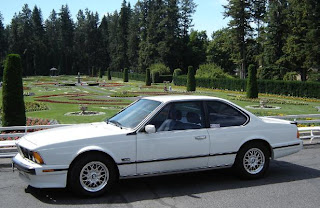Bmw 635
Bmw 635

Bmw 635
BMW is a company with a long tradition of participation in motorsports. In the 1970’s, the CS and CSi version of the BMW 3-series had found success as lightweight racers on several different circuits. In the 1980’s, BMW wanted to continue the performance concept with a slightly larger coupe that would be a good fit between their midsize sedan, the 5-series, and their large car, the 7-series. The E24 chassis was born, and with it the 6-series sedans. One of the most powerful versions of this vehicle was the 1989 BMW 635 CSi.

Bmw 635
The BMW 635 was visually quite distinctive. The front of the car jutted out over the bumper, giving the grille and headlights a reverse rake and lending the vehicle the nickname of ‘the shark’. The car’s rear deck sloped down to a flat trunk offset by a horizontal lip wing. The car also shared the same circular quad headlights that had been a BMW trademark for decades. The big coupe was powered by the 3.5 liter M30 engine, which in the 635 CSi produced 215 horsepower and 232 lb-feet of torque – quite impressive by the standards of the day. The 635 CSi found direct competition in the Porsche 928, which was powered by a 300 horsepower V8. This gave it superior performance to the BMW, but the lack of anything more than vestigial rear seating put it behind the 6-series in terms of interior comfort. Leather seats, dual-zone climate control and a well-developed suspension helped make the ride of the 635 CSi a fine balance between sport and performance.

Bmw 635
This is not to say that the 635 CSi was a slouch in the performance department. The coupe could reach 60 miles per hour in 8.4 seconds and had a top speed of 135 miles per hour. A trailing arm rear suspension kept the car stable during high-speed cornering, despite the significant 3300 lb weight of the car. The 635 CSi could be had with a 4-speed automatic or 5-speed manual transmission. The BMW 635 CSi continued on the tradition of the 3-series on the race track, winning the 24 hours of Spa-Francrochamps and several European Championship races during the campaign of Schnitzer Team BMW. The driver was Gerhard Berger, who would go on to become BMW’s Director of Motorsport.

Bmw 635
1989 was the final year for the 635 CSi, and it was considered the best year from an aesthetics perspective, at least in North America. American crash regulations had historically been stricter than those found in Europe, and as a result many of the European cars that had been imported had also been refitted with ugly steel bumpers which stuck out like a sore thumb in the front and the rear. For 1989, BMW was able to fit the 6-series with reinforced bumpers that also molded into the lines of the vehicle, greatly improving the overall look.

Bmw 635
When production ended in April in 1989, BMW decided that the next iteration of their coupe would be much larger, with an emphasis on luxury instead of sport. The 8-series would take its place in the BMW model lineup, but it would have a much shorter run than the 6-series, as buyers were disenfranchised with the lackluster performance offered at such a high price tag. The 8-series was even heavier than the 6, and despite being equipped with a V8 and an optional V12 engine, there was no mistaking it for a serious performance vehicle. BMW put the coupe out of its misery after only a few years of production, waiting until the mid-2000’s to re-introduce a large coupe. This time, they used the 6-series moniker again and found much greater success.

Bmw 635

Bmw 635

Bmw 635

Bmw 635

Bmw 635
0 comments:
Post a Comment